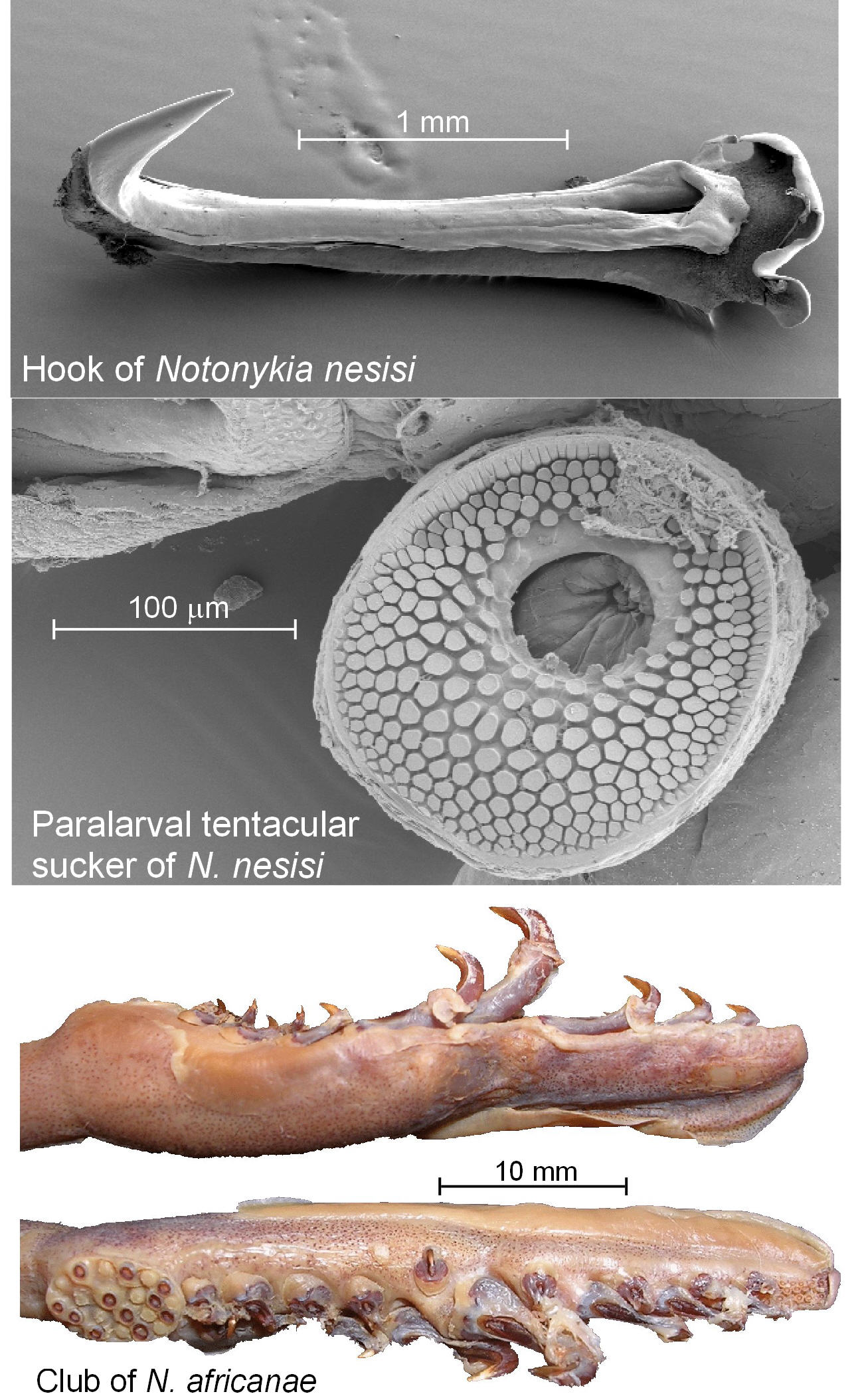

Earth and Oceanic Sciences Research Institute, Auckland University of Technology,
WL Level 1, 31-33 Symonds St, Auckland 1142, New Zealand. kbol...@aut.ac.nz

Squids in the family Onychoteuthidae Gray, 1849 ('hooked' squids), are most readily identifiable by the double row of hooks on each tentacle club, and the adentate (smooth-ringed) suckers on each arm. Onychoteuthids occur throughout the world's oceans, are taken frequently in deep-sea fisheries bycatch, and are ecologically important in the diets of many marine predators including cetaceans, pinnipeds, sharks, and seabirds. However, the diversity and systematics of the family have been poorly understood. Of the 60+ nominal species, 15 or 16 have generally been considered valid in recent studies (e.g. Nesis 1987, Kubodera et al. 1998). Challenges to clarity include insufficient species descriptions (the most meagre, from 1818, comprising two lines simply identifying the squid as possessing hooks), original descriptions published in six languages and often based on early life stages (not yet displaying the most important systematic characters, resulting in two frequently cited genera, Moroteuthis and Chaunoteuthis, likely representing life stages of other genera), lack of type material (non-extant or never designated for over half of the named species), and the existence of several unresolved species complexes. My doctoral research therefore encompasses a comprehensive revision of the Onychoteuthidae, involving critical appraisal of each nominal taxon, examination of type material wherever possible, the identification of new characters and character states for differentiating cryptic species, and a subsequent redescription of each valid species in the family (estimated at ~22).
Initially, collections were examined at New Zealand institutions (Museum of New Zealand Te Papa Tongarewa and the National Institute for Water and Atmospheric Research), and the New Zealand fauna (five species) was redescribed (Bolstad 2007). During the course of this research sexual dimorphism in the lower beaks of one species, 'Moroteuthis' (= Onykia) ingens, was observed, and the distinct morphologies were described in detail for the first time (Bolstad 2006). Since this species occurs frequently in the local diets of sperm whales and other squid-eating marine mammals and since beaks are frequently the only body part remaining undigested in the stomachs of predators, sex-specific equations were also derived for estimating the volume and mass of O. ingens taken as prey, based on beak size
Overseas collections housing type material were subsequently examined, including those of the South African Museum, the Smithsonian Institution, and the Rosenstiel School of Marine and Atmospheric Science. In late 2007, with the generous support of the London Malacological Society, most of the remaining type specimens (15) and a further 790 specimens were examined at the British Museum of Natural History; the Zoological Museum, Universitetet i Bergen; the Muséum National d'Histoire Naturelle; and the National Science Museum, Tokyo. Observations made in situ and later on loaned material have permitted the identification of several new species (including separation of five cryptic species within the problematic Onychoteuthis 'banksii' complex) and the recognition of several new characters useful in diagnosing onychoteuthid species, resulting in a manuscript currently under review.
The family revision is nearing completion. A list of dubious taxa is in preparation, and will be submitted to other teuthologists for consideration, and ultimately to the ICZN. Full morphological redescriptions and illustrations of each species will be presented in my thesis, including the historically recognised important characters (general external morphology, body proportions, tentacle clubs, photophores, gladius ('pen'), lower beak, radula) and the more recently developed characters (palatine teeth*, detailed morphology of the tentacular hooks in adults, tentacular suckers in paralarvae**, chromatophore patterns). Evidence for generic and specific synonymies will be carefully weighed and discussed, as will relationships between taxa. Although a genetic component to this study has not yet been possible, tissue samples have been taken and preserved from fresh material wherever possible, for assessment when material is sufficient to conduct a meaningful genetic study. Morphological observations have, however, generally agreed with genetic studies undertaken in the past (e.g. Bonnaud et al. 1998).
Several systematic riddles remain. The ubiquitous Onykia caribboea, a name given to paralarvae and juveniles of a certain appearance from most tropical and temperate oceans, almost certainly represents early ontogenetic stages of a known species of the younger genus 'Moroteuthis.' The genus Walvisteuthis, originally described in its own new family (Walvisteuthidae, Nesis and Nikitina, 1986), may belong to the Onychoteuthidae, but the type specimen is not available for examination, and the description suggests that some characters would be very unusual for an onychoteuthid. In the coming months, these questions will hopefully be answered through examining loaned material, made possible by The Society, who have assisted greatly in resolving the unstable Onychoteuthidae.
*teeth distributed over the inner face the palatine palps, which flank the radula on each side
**early ontogenetic stage, before the medial rows of tentacular suckers have developed into hooks
References
| Bolstad, K.S. 2006. Sexual dimorphism in the beaks of Moroteuthis ingens Smith, 1881 | |
| (Cephalopoda: Oegopsida: Onychoteuthidae). New Zealand Journal of Zoology 33: 317-327. | |
| Bolstad, K.S. 2007. Systematics and distribution of the New Zealand onychoteuthid | |
| fauna (Cephalopoda: Oegopsida), including a new species, Notonykia nesisi sp. nov. Rev. Fish Biol. & Fisheries, 17: 305-335. | |
| Bolstad, K.S. (submitted) Two new species and a review of the squid genus Onychoteuthis | |
| Lichtenstein, 1818 (Oegopsida: Onychoteuthidae) from the Pacific Ocean. | |
| Bonnaud, L.; Rodhouse, P.G.; Boucher-Rodoni, R. 1998. A Phylogenetic Study of the | |
| Squid Family Onychoteuthidae (Cephalopod: Oegopsida). Proceedings of the Royal Society of London 265: 1761-1770. | |
| Kubodera, T.; Piatkowski, U.; Okutani, T.; Clarke, M.R. 1998. Taxonomy and Zoogeography | |
| of the Family Onychoteuthidae (Cephalopoda: Oegopsida). Smithsonian Contributions to Zoology 586(2): 277-291. | |
| Nesis, K.N. 1987. Cephalopods of the world (English translation). Tropical Fish Hobbyist | |
| (T.F.H.) publications, Neptune City. 352 pp. | |